JAPANESE BASEBALL TEAMS
League competition was inaugurated in 1936. A system of two leagues, with six teams in each, was adopted in 1950. Three of the teams are owned by railway companies, two by newspaper organizations, and most of the others are under a type of corporatesponsorship arrangement. At present, the Central League is made up of the Chunichi Dragons (Nagoya); Hanshin Tigers (Osaka); Hiroshima Toyo Carp (Hiroshima); Tokyo Yakult Swallows (Tokyo); Yokohama Bay Stars (Yokohama); and Yomiuri Giants (Tokyo). The Pacific League is composed of the Chiba Lotte Marines (Chiba); Fukuoka SoftBank Hawks (Fukuoka); Hokkaido Nippon-Ham Fighters (Sapporo); Orix Buffaloes (Osaka); Saitama Seibu Lions (Tokorozawa); and Tohoku Rakuten Golden Eagles (Sendai). The Tokyo Dome or “Big Egg,” in Korakuen, Tokyo, was Japan’s first domed stadium. It has been followed by others in Fukuoka, Nagoya, and Osaka, enabling many games that might otherwise be postponed to be played during Japan’s rainy season. [Source: Web-Japan, Ministry of Foreign Affairs, Japan]
Most franchises in Japan here have been owned by the same corporate conglomerates for decades and have long-established ways of doing business. Japanese baseball teams include the Yomiuri Giants, owned by a newspaper conglomerate; the Hanshin Tigers, owned by a train and department store company; the Yakult Swallows, owned by a milk-drink empire; the Chiba Lotte Mariners, owned by a Korean-Japanese chocolate tycoon; and the Nippon Ham Fighters.The Bay Stars used be called the Taiyo Whales. Rakuten, an Internet conglomerate created in 1997, was awarded a baseball franchise for the 2005 season. Its baseball business has been led by executives in their mid-forties. They are known for taking more risks and trying new things compared to other teams.

Central League teams
The largest audience ever to watch a baseball game on television in Japan was a 48.8 share who watched a playoff game between the Giants and the Chunichi Dragons, who both were tied at the end of the regular season with 69-60 records.
According to 2005 Yomuri Shimbun survey the Giants were the most popular baseball team, supported by 37 percent of baseball fans. Hanshin was second (13 percent), followed by the Chunichi Dragons (7 percent) and Daiei Hawks (4 percent).
The Hiroshima Carp are known as the people’s team. Founded only five years after the atomic blast, they are owned by the Masuda family, the owners of Mazda and have repeatedly been bailed out from financial trouble by the local Hiroshima population. In the early years fans bought ownership tickets for ¥20 a month which helped get the team established. To stave off a hostile takeover bid in 2004, supporters raised $1 million in a campaign in which people placed their loose change in barrels scattered around the town.
Controversial American baseball player Pete Rose once dismissed Japanese baseball as equivalent to American Triple-A level at best. On that remark Japanese baseball expert Jim Allen wrote in the Daily Yomiuri: “Japan’s level of play is lower than in the Majors because the minimum talent level needed to earn a roster spot in the Central of Pacific leagues is lower than that in the American or national leagues. That being said, one rarely sees any of the world’s best players in Triple-A, but it is common in Japan.
The independent Japan-Future baseball league suspended activities after one of its teams, the Osaka Gold Villicanes, failed to find financing for the next season. The club, one of only two in the league, was connected with the sumo gambling sandal.
Websites and Resources
Good Websites and Sources: Japanese Baseball Teams: Yomiuri Giants Official Site (Japanese Language) giants.jp ; Wikipedia article on the Yomiuri Giants Wikipedia ; Hanshin Tigers Page www2.gol.com/users/michaelo/Tigers ; Hanshin Tigers Official Site (Japanese Language) hanshintigers.jp ;Hanshin Tigers Fan Page wallpaperman.tripod.com/Hanshin_Tigers_page ; Hanshin Tiger Blog tigerdude.com/japan/tigers ;
Links in this Website: SPORTS IN JAPAN (Click Sports, Recreation, Pets ) Factsanddetails.com/Japan ; JAPANESE BASEBALL Factsanddetails.com/Japan ; JAPANESE BASEBALL RULES, CUSTOMS AND FANS Factsanddetails.com/Japan ; JAPANESE BASEBALL TEAMS Factsanddetails.com/Japan ; JAPANESE BASEBALL PLAYERS Factsanddetails.com/Japan ; JAPANESE MAJOR LEAGUE PLAYERS Factsanddetails.com/Japan ; JAPANESE MAJOR LEAGUE PITCHERS Factsanddetails.com/Japan ; ICHIRO SUZUKI Factsanddetails.com/Japan
Good Websites and Sources on Baseball: Good Photos at Japan-Photo Archive japan-photo.de ; Pro Yakyu Now japanesebaseball.com ; Japan Baseball Daily japanbaseballdaily.com ; BaseballGuru baseballguru.com ; Japan Times Baseball Page japantimes.co.jp ; PBS Documentary on Japanese Baseball wbgu.org/community ; Japan Visitor japanvisitor.com ; Links and Baseball Cards robsjapanesecards.com ; Japan orama japanorama.com ; Wikipedia article Baseball in Japan Wikipedia ; Wikipedia article on Professional Baseball in Japan Wikipedia ; Pro Yakyu Forum, with Blogs and Discussions on Japanese Baseball japanesebaseball.com ; Sites That are a Little Old and Outdated But Still Have Good Info Jim Allen’s Japanese Baseball Page (old site) gol.com/users/jallen/jimball ; japanball.com ; Nisei Baseball niseibaseball.com ; Books: “The Mining of Ichiro” (2004), “ You Gotta Have Wa” (1989) and “The Chrysanthemum and the Bat” (1977) by Robert Whiting.
Articles on Japanese Baseball: Negative Impact of Japanese Success in the Major Leagues time.com/time/world/ ; World Baseball Classic worldbaseballclassic.com ; Early Days of Japanese Baseball international-baseball.suite101.com ; New York Times article om Japanese Fans travel.nytimes.com ; Baseball Hall of Fame Timeline on History of Japanese Baseball english.baseball-museum.or.jp ; Academic Paper on Japanese Baseball /www.economics.hawaii.edu
Koshien Stadium is the home of the Hanshin Tigers, a major institution in Osaka. Try to see a game if you can. The park is nearly always filled and the fans are fanatic as Red Sox fans except they pound plastic thunder sticks and do organized cheers throughout the game and set off balloons en masse in the seventh inning. Koshein is Japan’s oldest extant stadium. Built in 1924, it also hosts Japan’s main high school baseball tournaments, spectacles in themselves that can be viewed for free in the spring and summer.
Japanese Baseball Season
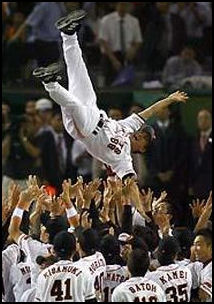
Yomiuri Giants celebrate
Japan Series victory The 130-game Japan League season lasts from April to October. The Japan Series matches the winner of the Pacific League against the winner of the Central League. Japanese players play about 30 games less than their American Major League counterparts. No road trip is more than four hours away by train.
There are 20 percent fewer games in the Japan Leagues than in the Major Leagues. Japanese players play 144 games compared to 162 in the Major Leagues. Up until 2005 Japanese played 130 games.
The Japan League has a best-two-out-of-three All Star series.
June is dominated by interleague games. The Pacific League slammed Central League 81-47-4 in 2010 and 78-57-9 in 2011. Some have suggested the reason for this is the wider strike zone in the Central League (about one baseball width wider), which is easier for Pacific League pitchers to adjust to do than for Central league pitchers to adjust to a smaller zone. Others say it because the Pacific League uses designated hitters and have better quality designated hitters available when they play at home. Yet others say the Pacific League is simply better
The 2011 professional baseball season was delayed by 18 days because of the earthquake and tsunami disaster. There were some who thought it should be called off altogether. A big cheer was let out when the Sendai-based Tohuku Rakuten Golden Eagles played their first game of the season. Sendai was the largest city devastated by the quake and tsunami. The game — played against the Lotte Marines near Tokyo in Chiba — was delayed for two minutes in the forth inning because of an aftershock.
Japanese Post Season Play and the Japan Series
The Japanese play off system is rather weird. After the regular season is over, in the first stage of play off, the second and third place play each in a best three out of five series to determine who plays the pennant winner in each of the Pacific and Central League. The league championship series is a best four out of seven except the pennant winner is a given a one game advantage over the first stage winners before the games even start as a reward for placing first in the league.
Postseason play in 2010 consisted of a Climax Series and the Japan Series. The First Stage of the Climax Series is a best-of -three Series with the 3rd place team playing 2nd place team at the 2nd place team’s home field. The Central League series begin on October 16 and Pacific League’s series begins on October 9th. . The Second Stage the Climax Series is a best-of-seven series pitting he First Stage winner against the league champion, who begins with one win, with the Central League series starting on October 20th and for the Pacific League beginning on October 14th. The Japan Series is a best-of-seven series that begins at the home field of the Central League Climax Series champion on October 30th.
Before Japan Series games, the teams not the individual players are announced and managers walk out clutching a bouquet of roses. The winner of the Japan Series celebrate by pouring beer over one another rather than champagne. Teams that win a a Japan Series, league championship or pennant heave the coach in the air like Eskimos with a seal-skin blanket.
There are plans for the winner of the Japan Series to play the winner of the Korean Series in November after teams in each country’s professional leagues are finished playing.
Yomiuri Giants
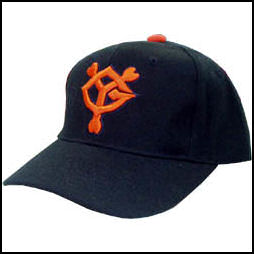
Over the years, the most successful team in the Japan League has been Tokyo's Yomiuri Giants. As dominant as the New York Yankees over the years, they have won 32 Central League pennants and 21 Japan Series, including nine in a row between from 1965 to 1973.
Many Japanese whether they live in Tokyo or not are fans of the Yomiuri Giants. Nearly All the Giants home and away games are sell outs and every one of their 130 games is broadcast on network television (some other teams, by contrast, are lucky to get one game a month on television).
One reason people from all over Japan are Giants fans is that for many years, during the 1960s and 70s, they were the only team you could watch on television and read about in Japan’s largest newspaper because of the power of Yomiuri Shimbun had in media. The Giants have been so popular than when they win a pennant or a Japan Series the economy often improves as people spend money to celebrate.
The average salary of the Giants in 2003 was ¥108 million, almost double the Japan League average. Giant games get considerably more coverage than an other team.
Success of the Yomiuri Giants
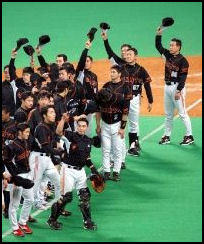
The Giants won nine straight Japan Series from 1965 to 1973 with “O-N duo” of Sadaharu Oh and Shigeo Nagashima as the clean up batters and the player-manager Tetsuharu Kawakami as manager. One fan recalled, “When I was a kid our family watched the Giants play every nigh on TV, and it was always Oh and Nagashima that dominated our conversation. Nagashima was something of genius but I always preferred Oh who worked diligently and patiently.”
Nagashima's Yomiuri Giants won the Japan Series in 2000, defeating Oh's Daiei Hawks. The Giants were good in 2002 the last year Matsui was with the team and were mediocre after he left. See Matsui, Major League Players
The Giants won their 31st Central league title and their first pennant in five years in 2007 with a dramatic, come-from-behind win over Yakult in the last game of the season but lost the Central League playoff to the which Dragons and failed to advance to the Japan Series, In 2008 they were 13 games out of first in early July but finished strong — 42-19-1 compared to Hanshin’s 30-33-2, who spent most of the season in first place — to capture the pennant in the second to last game. It was the greatest comeback in Central League history.
The Giants won their third straight Central League pennant in 2009 and then won the Fapan Series, winning the final game against the Fighters in unusual fashion. Starter Shun Toro left injured after facing just four batters and five pitchers combined on a 2-0 shut out.
Giants Coach Pays $1.2 Million in Blackmail Money
An article in the June 28 2012 issue of Shukan Bunshun was headlined, "Yomiuri Giants Manager Tatsunori Hara paid 100 million yen to former member of organized crime syndicate." According to the article in 2006 Hara met off two men with organized crime connections who said they had a diary with entries about Hara's relationship with a woman around 1988. The men demanded 100 million yen ($1.2 million) to prevent it from being made public. [Source: Yomiuri Shimbun, June 22, 2012]
The Yomiuri Shimbun reported: “Hara did not consult with the club and paid the men the money, the Giants said. According to the baseball team, this is because the names of two men who played for the Giants around 1988 were also mentioned in the woman's diary. Since the two became Yomiuri coaches in 2006, Hara thought the team would be rocked if the diary was made public and that the man who claimed to be connected to pro baseball would likely help him, the team said.
The baseball club said it became aware of the problem in April 2009 after another man visited the club. The club quoted the man as telling it to "return the diary that was given to the manager or I'll cause a commotion about it." The Yomiuri Giants investigated the matter and discovered Hara had been blackmailed. The baseball club and Hara considered filing a formal report with police but decided not to because the company employee who demanded Hara pay 100 million yen had since died and the police would find it difficult to pursue the matter as a criminal case.
The Yomiuri Giants denied allegations that the two men who blackmailed Hara, and another man who threatened the baseball club, were gangsters and filed a damages suit against publisher Bungeishunju Ltd., claiming that an article in a weekly magazine defames Yomiuri Giants Manager Tatsunori Hara and the pro baseball club. Yomiuri Giants President Tsunekazu Momoi told reporters, "It's not true that Manager Hara paid money to an antisocial group." According to the baseball club that of the two men that Hara met one was a man who claimed to be connected to a certain professional baseball team and the man was a company employee
Momoi said the baseball club has no plan to dismiss Hara over the magazine article because: 1) Hara was a victim of blackmail and did not provide money to antisocial groups; 2) Hara has no personal relationship with antisocial groups and no record of using such groups; 3) Momoi said he and Hara believe former Yomiuri Giants General Manager Hidetoshi Kiyotake, who was dismissed by the club for disclosing confidential information, is involved in the magazine's report. Momoi said he suspected so because only Kiyotake and three other people knew the details of the blackmail. Momoi also said Kiyotake told a Giants official before his dismissal that he knew of "Hara's weak points."
Hara apologized to Giants fans after the team's training session in Kawasaki. "I'd like to express my sincerest apologies to fans over the current situation. I regret my actions from the bottom of my heart," Hara told reporters. Prior to the apology, Hara released a message addressed to Kiyotake saying: "There has been a spate of reports damaging the reputations of Yomiuri Giants players and related people recently. How could this happen "Could it be done by anyone other than you, Mr. Kiyotake — I'm relieved this latest report was about me. I hope you'll live your life with pride that you were once a member of the Yomiuri Giants."
Giants to Sue Asahi Shimbun over Report About Pay-Offs to Promising Recruits
On March 15 and 16, 2012, the Asahi Shimbun reported that the Giants had agreed to pay a total of 3.6 billion yen in contract amounts to six new recruits from fiscal 1997 to fiscal 2004, exceeding by 2.7 billion yen the limit agreed upon among all pro baseball teams in Japan. However, the reported "contract amounts" actually included signing bonuses and additional bonuses based on their performance. [Source: Yomiuri Shimbun, July 14, 2012]
In July 2012, The Yomiuri Giants have said they plan to file a damages suit against The Asahi Shimbun, as the paper has failed to retract a story about the Giants said was erroneous, claiming the Asahi report libeled the team and its players, and violated the players' privacy.
In September 2001, the Giants reviewed a system on signing bonuses when the draft's free selection segment--in which teams each can sign up one top-level amateur player prior to the annual draft--was introduced. Subsequently, the Giants introduced a performance-based wage system in which a bonus is added to an annual wage only when players achieve a certain level of performance. The team renewed contracts with its players based on the new system.
Under the system, some players who failed to meet required conditions did not receive the additional bonuses. However, the Asahi ignored such facts and reported only incorrect contract amounts, which actually comprised annual wages and additional performance-based bonuses. However, the Asahi committee denied the significance of additional rewards. "What is agreed to be paid to new recruits in return for joining the team should be considered as contract money, regardless of the names, methods and terms of payment," the committee said.
Hanshin Tigers
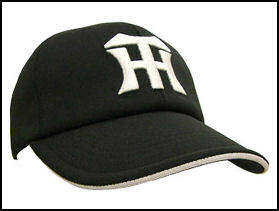
Osaka's Hanshin Tigers equal the Giants in notoriety. Regarded as the Chicago Cubs or the Boston Red Sox of the Japan League, they have been perennial losers who have reputation for blowing big leads and committing errors at the worst possible time and leading the division early in the season and squandering their lead with a long string of loses in July and August.
Hanshin's longtime manager, Katsuya Nomura, was very popular and his job seemed secure even after his team finished last three years in a row. In 2001, his wife Sachiyo was charged with evading $2 million in taxes and Nomura was immediately forced to to resign. Even though he called his wife a Doberman he refused to divorce her.
The Tigers were turned around by Senichi Hoshino who had previously had success coaching the Chunichi Dragons and retired after the 2003 season because his blood pressure was too high. He was credited with bringing discipline to a team known making errors and instilling a sense of never-give-up fighting spirit in a team known for choking.
Under Hoshino in 2003, the Tigers won 46 and lost only 15 of their home games, including a long string of games early on the season. They pretty much had the season wrapped up by June Hanshin lost the Japan Series to the Fukuoka Daiei Hawks in seven games. Hanshin won their three home games but lost all their away games, including the seventh final game 6-2. After the loss, 400,000 people showed up for a parade to honor the team. That was many more times people than showed up for the Hawks victory parade.
Hanshin did poorly in 2007. In 2008, the Tigers blew a 13 game lead in July to finish second to the Giants in the Central League race. The Tigers were in first place nearly the entire season but lost the pennant to the Giants in the last week. Hanshin still had a healthy lead at the beginning of September but then lost nearly ever head to head game against the Giants. Hanshin then proceeded to lose to Chunichi in the playoffs. Chunichi won the last game 2-0 with a two-out, two-run home by Tyrone Woods against pitcher Kyuji Fujikawa in the ninth inning to give Chunichi.
Hanshin Fans
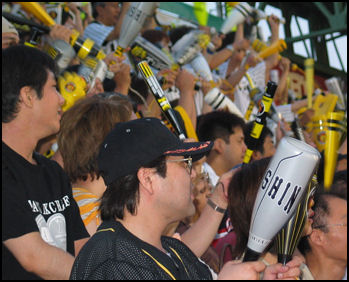
Hanshin fans are famous throughout Japan and the enthusiasm is equated with fanaticism. The die hard fans often show up the games hours in advance to practice fight songs that the relentlessly chant throughout the game while banging plastic bats. If the team lose the fans often blame themselves for not cheering enthusiastically enough. Sometimes when the Tigers play away games Hanshin fans come in such numbers it seems like Hanshin is playing a home game.
Hanshin draws 2.5 million to 3 million people a year to their home games. The playing area of Hanshin’s home field, 53,000-seat Koshien Stadium, used to be surrounded by a barbed wire fence to keep fans from attacking opposing team members. Sometimes the fans need protection from themselves.
In 2003, fifty-three people received medical attention when a tear-gas like substance was released during a clash between Hanshin fans and Chunichi Dragon fans at a baseball stadium in Gifu. The clash broke out after the game when a ground of Hanshin fans jumped on the field and taunted Chunichi fans and the Chunichi fans responded by jumping on the field and fighting with the Hanshin fans despite the presence of police. A similar incident in the mid 1980s led to the installation of the fence around the playing field at Koshein in 1985.
Koshien Stadium is the home of the Hanshin Tigers, a major institution in Osaka. Try to see a game if you can. The park is nearly always filled and the fans are fanatic as Red Sox fans except they pound plastic thunder sticks and do organized cheers throughout the game and set off balloons en masse in the seventh inning. Koshein is Japan’s oldest extant stadium. Built in 1924, it also hosts Japan’s main high school baseball tournaments, spectacles in themselves that can be viewed for free in the spring and summer.
Yomiuri Giants wins 22nd Japan Series Title in 2012
The Yomiuri Giants defeated the Hokkaido Nippon Ham Fighters in Game 6 to win the Japan Series 4-2. It marked the Giants' first championship in three years and 22nd overall. The Giants also defeated Taiwan's Lamigo Monkeys to win the Asia Series for the first time. The victory gave the Giants the fifth title of the season, after winning the interleague championship, the Central League pennant, the Climax Series and the Japan Series.
The Yomiuri Giants won their 22nd Japan Series Title in 2012, defeating the the Hokkaido Nippon Ham Fighters four games to two. On the final game, The Yomiuri Shimbun reported: “Shinnosuke Abe did a lot to help carry the Yomiuri Giants to a Central League title and into the Japan Series, but his teammates made a huge impact in securing the club's 22nd championship. Abe's tie-breaking single in the seventh inning of Game 6 at Tokyo Dome on Saturday night lifted the heavily favored Giants to a 4-3 win over the Hokkaido Nippon Ham Fighters to take the series 4-2. [Source: Daily Yomiuri, November 5, 2012]
But his effort was the result of the resilience and depth the team exhibited while wresting the Series away from the Pacific League champions. A bad right knee slowed Abe--keeping him out of Games 4 and 5 in Hokkaido--but the Giants captain returned to the cleanup spot in the Series clincher. "As our main man, he really came through in that spot for us," said Giants manager Tatsunori Hara of Abe's game-winning single up the middle.
"That was an extremely meaningful hit. We took a difficult path to this championship, but everyone believed in the team. "I'm just filled emotion," said Hara, adding, "We can get better." Abe said he had to put the injury out of his mind. "When your body's in pain, if you think about something else, you get past it," said Abe, who just missed winning the triple crown.
Before Abe came through, however, his teammates helped lay the groundwork. Part-timer Kenji Yano put the Giants up 2-0 in the first inning with a bases-loaded single off the wall down the line. Hisayoshi Chono, who batted .375 in the Series and was named Outstanding Player along with Abe and John Bowker, homered in the second to help KO Fighters starter Masaru Takeda. Chono, who hit safely in all 12 of Yomiuri's postseason games, scored the winning run in the seventh after drawing a leadoff walk.
Ace Tetsuya Utsumi earned the MVP award for posting two victories. The southpaw worked seven scoreless innings to win Game 1, and limited the Fighters to two runs over eight innings in Game 5 with the Series tied at two games apiece. Meanwhile, the Fighters battled back from an early three-run Game 6 hole but couldn't deliver the knockout blow. They had just two base runners until the sixth inning, when Yang Daigang and Yoshio Itoi both singled to bring up struggling cleanup hitter Nakata with two outs. The slugger took Sawamura deep for his first Series homer--and first RBIs--to tie the score at 3-3. Nippon Ham, however, couldn't battle past the Giants. The Fighters loaded the bases for Itoi, the PL Climax Series second-stage MVP, and he sent a bullet to right field. But it was right at Chono, who backed up to the wall before squeezing it in his glove.In the ninth inning, a walk and a two-out, pinch-hit single by Shinya Tsuruoka set up Itoi for another chance, but he grounded out to short to end the game.
The Giants followed up the Japanese Series win by claiming the Asia Series title. The Korean Times reported: “Japanese baseball champs Yomiuri Giants defeated the Lamigo Monkeys of Taiwan 6-3 to claim in the finals game at Sajik Stadium, about 450 kilometers southeast of Seoul. Twenty-year-old starter Ryosuke Miyaguni pitched six effective innings, as the Giants got offense from unexpected sources for their first continental win. The Giants, which took home 500 million won ($459,500) in prize money, became the fifth Japanese team to win the Asia Series. Shortstop Hayato Sakamoto was named the most valuable player of the tournament. He was 4-for-13 in three games with four runs batted in (RBI). Korea served as the first-time host of the Asia Series, which began in 2005. This year's event had six teams from Korea, Japan, China, Taiwan and Australia. Yomiuri beat the Perth Heat of Australia and the Lotte Giants of South Korea to reach the final. [Source: Korean Times, November 11, 2012]
Hanshin Fan Victory Celebrations
When the Tigers won their first Japan Series in 21 years in 1985, fans went nuts and jumped off a bridge into the foul, polluted Dotonbori River. During the season the fans spent such money on games and booze and souvenirs such as Tiger beer, Tiger soap and Tiger underwear that nearly a half a billion dollars was pumped into the Osaka economy. In a poll of Japanese newspaper readers picked the outbreak of Tigermania as one of the top ten domestic news stories in 1985.
When the Tigers won their first pennant in 18 years in 2003, the fans again went nuts wild. Again they jumped off a bridge into the foul, polluted Dotonbori River. More than 5,300 did it, including four who were arrested for leaping in naked. This time someone died, a 24-year-old man. The government was worried the bridge people jumped off of might collapse. Before 2003, the Tigers finished in last place in 10 of the 18 years.
As part of the celebration stores of all kinds throughout Osaka offered Hanshin discounts. So many people tried to get into a Hanshin department store in downtown Osaka, admission had to be restricted in the Hanshin merchandise section of the store. Some people waited in line starting at 6:00am just to be the first to get their hands on Hanshin mugs and megaphones.
Chunichi Dragons
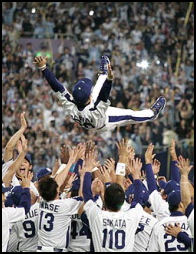
Dragons celebrate in 2007 The Chunichi Dragons won the 2007 Japan Series, defeating the Nippon Ham Fighters in five games with a 4-1 victory in the last game. It was their first title since 1953. The Dragons won the last game 1-0. Starting pitcher Daisuke Yamai was pitching a perfect game after eight innings when his coach yanked him and put in the team’s star closer If Yamia had pitched a perfect game it would have been the first in Japan Series history. The series was rematch of the previous year when the Fighter prevailed,
Chunichi won the Central League series in 2007 sweeping the best of five series against the Yomiuri Giants with a 4-2 victory in the third game. The Dragons finished second in the Central League The Dragons had finished second to the Giants in the regular season, winning the last five games of Central league season. The Dragon played the Taiwan Lions in the Konami Cup for the Asian club baseball championship.
The Dragons have appeared in the Japan Series eight times, They lost to the Seibu Lions in seven games in the 2004 Japan Series,
In 2008 Chunichi made to the 2nd stage of Central league champion with a two game victory in a three game series with Hanshin that climaxed with a two-out two-run home by Tyrone Woods in the ninth inning to give Chunichi a 2-0 victory in the third game..
The Yakult Swallows won the Japan Series in 2001.
Fukuoka Softbank Hawks
The Fukuoka Daiei Hawks (now known as the Softbank Hawks), managed by Sadaharu Oh, won the Japan Series in 1999. It was the Hawks first championship since 1964 and Oh's first championship as manager. Nagashima's Yomiuri Giants won in 2000, defeating Oh's Daiei Hawks; and the Yakult Swallows won in 2001. The Giants won in 2002. The Hawks in 2003.
In 1995, home run king Sadaharu Oh began managing the Daiei Hawks, then the worst team in the Pacific League. In his first year with the Hawks the club finished in forth, 26 ½ games out of first place. In the next two years the Hawks finished sixth and forth. In this period angry Hawks fans pelted the team bus with eggs. The club steadily improved after that. In 1998 the Hawks finished third. In 1999 they won the league and the Japan Series. By 2003 they had won the league three times and the Series twice. In 2004 and 2005 the Hawks won the regular season only to loss on the play-offs.
The Softbank Hawks were the Pacific League champions in 2011. It was the Hawks 15th title.
Fukuoka SoftBank Hawks Win 2011 Japan Series
Six times a bridesmaid in seven years in the Pacific League Climax Series, the Hawks made it to the Japan Series, where they beat the Chunichi Dragons in seven games, capturing their 1st Japan Series title since 2004. On the last game, the Yomiuri Shimbun reported: “Standing on first base after delivering a run-scoring single in the seventh inning, Seiichi Uchikawa was awed by the explosive applause of the home crowd. "So this is what it feels like to be No. 1 in Japan," Uchikawa said to himself. Two innings later, that's just what the Fukuoka SoftBank Hawks were, winning the Japan Series with a 3-0 victory over the Chunichi Dragons in the decisive seventh game at Fukuoka Yahoo! Japan Dome. [Source: Yomiuri Shimbun, November 22, 2011]
Toshiya Sugiuchi and three relievers combined on a four-hit shutout as the Hawks won their first title since 2003 and fifth overall. Oddly enough, the Hawks' win was the only one secured by the home team in the series. In the previous six games, the visiting team came out on top. Koji Akiyama, who tasted victory numerous times as a player with the Seibu Lions and Hawks, won his first title as a manager in his third year at the helm.
"The players gave everything they had for all seven games," said Akiyama, who couldn't stop his tears as the team celebrated on the field. Veteran Hiroki Kokubo, who batted .320 with two RBIs for the series, was named the MVP. At 40, he becomes the oldest MVP in series history; the previous oldest was Akiyama, who was 37 when he won the award in 1999 with the Hawks.
For Chunichi manager Hiromitsu Ochiai, the series loss was a disappointing way to end a generally successful run at the helm of the Dragons. The team announced in September that Ochiai would step down after eight seasons, which included one Japan Series title and four Central League pennants. "These guys are fantastic," Ochiai said. "It's been a great eight years."
Uchikawa, who led the Pacific League in batting but had struggled in the series, helped put the nail in the Dragons' coffin with his RBI single off reliever Takuya Asao that gave the Hawks a 3-0 lead. It was his only RBI of the series. "If I had done more, it would have made things easier for us," Uchikawa said. Sugiuchi, who had a no-decision in the Hawks' extra-inning loss in Game 2, capped a trying year by allowing three hits in seven scoreless innings.The 2003 series MVP had shoulder problems this season that limited him to eight wins. "It was tough, but today's victory made it all special," he said.
The reached the Japan Series by defeating the Seibu Lion in thrilling fashion. The Daily Yomiuri reported: “The Hawks brushed aside seven seasons of frustration, when they won the Pacific League Climax Series and earned a spot in the Japan Series.The Hawks had been in the playoffs in six of the seven previous years, including four times as the PL's top seed, but this is the first time they have won the final stage. Game 3 ended in a 2-1, 12th-inning sayonara victory over the Saitama Seibu Lions after Yuya Hasegawa's 10th-inning double tied the game. [Source: Daily Yomiuri, November 6, 2011]
Seibu Lions
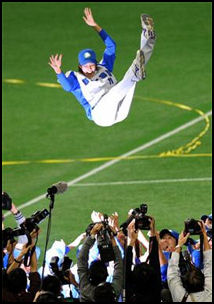
Lions celebrate in 2008 The Seibu Lions have traditionally been the best team in the Pacific League. They have won 21 league titles and 15 Japan Series and were the team that Daisuke Matsuzaka played for bdfore he went to the Boston Red Sox. The Lions won the Japan series in 2004 and 2008 by winning the final two games in their opponent’s park.
The Seibu Lions won the Japan Series over the Yomiuri Giants in 2008. The Lions won the last two games at the Giant’s home turf at the Tokyo Dome after the Giants went up 3-2 in Game Five after a hustle-filled four-run 7th inning led by Alex Ramirez. The most valuable player was Lion’s pitcher Takayuki Kishi. He started off the series with a 147-pitch shut out and set a series record for the most innings without allowing a run (14½)
The Lions were lead by first-year manager Hisanobu Watanane and came back after finishing in fifth place in 2007, the first time they were out of the top three in 26 years. To make the series they won the Pacific League pennant and beat Nippon Ham in the Pacific League Climax series.After the Japan Series the Lions won the Asian Series in dramatic fashion with a 1-0 victory over the Taiwanese team Uni-President with a walk-off, Sayonara double by Tomoaiki Sato. It was the forth straight title for a Japanese team.

Pacific League teams
Nippon Ham Fighters and Lotte Marines
The Hokkaido Nippon Ham Fighter, under American Trey Hillman won the 2006 Japan Series defeating the Chunichi Dragons in five games after losing the first game and knocking off the Softbank Hawks and Seibu Lions in the playoffs to win the Pacific League title. It was the first time the Fighters had won since 1962 and the second year in a row an American coach managed a Japan Series champion. A few weeks later the Fighters beat Taiwan’s best team, La New Bears to claim the title of Asia’s best baseball club team.
The Nippon ham Fighters win in the 2006 Japan Series was their first title in 44 years. Some 143,00 fans braved snow and frigid temperatures in Sapporo in the victory parade that follows series. Nippon Ham won the Pacific League series in 2007 beating the Chiba Lotte Marines 6-2 in the fifth and final game and then lost to Chunichi in the Japan Series. The team moved to Sapporo from Tokyo in 2004.
The Hokkaido Nippon Ham Fighters won their third Pacific League pennant in four years in 2009 but lost to the Giants in the Japan Series..
The Chiba Lotte Marines, under American Bobby Valentine, in his second year as coach, won the 2005 Japan Series defeating the Hanshin Tigers in four straight games after knocking of Softbank Hawks and Seibu Lions in playoffs to win the Pacific League title. It was the first time the Marines had won in 31 years. They went on to defeat South Korea’s Samsung Lions in four straight games to win the inaugural the Asia Series championship. The Marines had traditionally been regarded as losers. Among those on the team were former Met Benny Agbayani. Before Valentine left in 2009 more than 50,000 Chiba Lotte Marines fans signed a petition to try to get the team to change its mind and allow Valentine to stay.
Lotte Marines Win 2010 Japan Series in Dramatic Fashion
The Lotte Marines won the Japan Series in 2010 in dramatic fashion, pulling out an 8-7, 12-inning victory in Game 7. The pervious day, the two teams battled to a 2-2, 15-inning tie that lasted 5 hours, 43 minutes, the longest Japan Series game in history. The final game has some great hitting and fielding as well as six missed bunt attempts.
Among the stars were Lotte submariner Shunsuke Watababe, a right-handed pitcher with an unorthodox pitching style he adjusted to the wind to blew away the Dragons in a 5-hit, 7-1 victory in Game 3.
The Marines — under first year manager Norifumi Nishimura — were the first team to qualify for the Japan Series after finishing third in their division. To win the series they had to overcome a number of obstacles. The had to play all their Pacific League Climax series games on the road and spotted the Fukuoka SoftBank Hawks a one-game lead in the second stage of the Climax Series. Rising to the occasion, the team won six of eight games. After the Japan Series the Lotte Marines went on to defeat South Korea’s No. 1 team Wyverns.
Jim Allen wrote in the Daily Yomiuri: “The finish of this year's epic Japan Series was baseball at its best. We had an underdog winning on the road and the longest game in Series history but unfortunately Games 1, 2 and 5 were not nationally televised.” Viewers had to watch them on satellite, cable and local TV because the usual broadcaster for the Chunichi games, TBS had a commitment to show the Women's Volleyball World Championship.
The Chunichi Dragons won Central League pennant in 2010. The Tigers and the Giants were in second and third place respectively. The Giants beat the Tigers in first round of the Climax Series even though the Tigers had the home field advantage. Chunichi prevailed over the Giants in the Central League playoffs. The Giants, Tigers and Dragons were neck and neck at the end of the 2010 season.
The Softbank Hawks won the Pacific League pennant in 2010. The Seibu Lions and Lotte Marines were in second and third place respectively.
Orix reached its first Pacific League play-offs in 2008.
In 1998, the Yokohama Bay Stars won their first Japan Series in 38 years.
Image Sources: 1) 3) 6) 7) 8) Japan Zone, 2) 4) Goods from Japan 5) Japanball.com
Text Sources: New York Times, Washington Post, Los Angeles Times, Daily Yomiuri, Times of London, Japan National Tourist Organization (JNTO), National Geographic, The New Yorker, Time, Newsweek, Reuters, AP, Lonely Planet Guides, Compton’s Encyclopedia and various books and other publications.
Last updated January 2013
